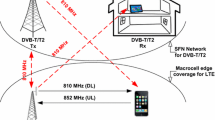Abstract
The surest way to guarantee that multiple wireless systems can concurrently exist harmlessly, when operating in the same or adjacent channel, is by analyzing spectrum overlapping. This paper proposes a more accurate model to evaluate the interference power from co-channel and adjacent channel of orthogonal frequency division multiplexing-based long term evolution-advanced (LTE-Advanced) towards broadcasting frequency modulation systems at 800 MHz. Power spectral density overlapping factor is employed, and closed form of the interference power loss is derived. Numerical results demonstrate that the proposed method evaluates more exact interference power than the advanced minimum coupling loss (A-MCL) method, where the co-channel and adjacent channel interference powers are reduced by 1.3 and 3 dB, correspondingly, compared to that obtained using the A-MCL method. This decreases the minimum separation distance between the two systems, which can eventually lead to efficient radio spectrum resources utilization.







Similar content being viewed by others
References
“4G Mobile Broadband Evolution: 3GPP Release 10 and Beyond—HSPA+SAE/LTE and LTE-Advanced”, 4G Americas white paper, February 3, 2011
Nee R, Prasad R (2000) OFDM for wireless multimedia communications. Artech House, Boston
Technical Requirements for Land Mobile Radio Services Operating in the Bands 768–776 MHz and 798–806 MHz, Aussi disponible en français—PNRH 511SRSP-511, Issue 2, April 2010
Prendergast D, Ledoux B, Lafleche S, Wu Y, Wang X, Caron B (2003) The effects of narrowband and wideband public safety mobile systems operation (in television channels 63/68) on DTV and NTSC broadcasting in TV channels 60–69 (746 MHz–806 MHz). Report CRC-RP-2003-001, April 2003
CEPT ERC Report 101 (1999) A comparison of the minimum coupling loss method, enhanced minimum coupling loss method, and the Monte-Carlo simulation. May 1999
Chung W-G et al (2006) Advanced MCL method for sharing analysis of IMT-advanced systems. Electron Lett 42(21):1234–1235
Jo H-S et al (2006) The coexistence of OFDM-based systems beyond 3G with fixed service microwave system. J Commun Netw 8(2):187–193
Kroeger B (2007) Adjacent channel interference mitigation for FM digital audio broadcasting receivers. US Patent 7221917, 2007
Analytical Graphics, Inc. (AGI) Evaluating Communications Links, Available from: http://www.agi.com/resources/help/online/stk/index.html?page=source%2Fextfile%2Fcomm%2Fcommradar10-01.htm
Spiegel MR (1968) Mathematical handbook of formulas and tables. McGraw-Hill Inc, New York
CEPT Report 24 (2008) Technical considerations regarding harmonization options for the digital dividend. July 2008
Wijting C et al (2009) Key technologies for IMT-advanced mobile communication systems. IEEE Wireless Comm Mag 16(3):76–85
Barclay LW (2003) Propagation of radiowaves. The Institution of Electrical Engineers, London
Shamsan ZA, Al-hetar AM, Rahman TA (2008) Spectrum sharing studies of IMT-advanced and FWA services under different clutter loss and channel bandwidths effects. Progress Electromagn Res 87:331–344
Acknowledgments
This work of Dr. Zaid Ahmed Shamsan is supported by the Postdoctoral Fellowship scheme, Research Management Center (RMC), Universiti Teknologi Malaysia (UTM).
Author information
Authors and Affiliations
Corresponding author
Appendix
Appendix
The infinite series summation in Eq. 11
Let \( {Q_k} = \frac{{\left( { - 1} \right)\left[ {{{\left( {{x_3}} \right)}^{{2k - 1}}} - {{\left( {{x_1}} \right)}^{{2k - 1}}} + {{\left( {{x_4}} \right)}^{{2k - 1}}} - {{\left( {{x_2}} \right)}^{{2k - 1}}}} \right]}}{{\left( {2k - 1} \right)\left( {2k - 1} \right)!}} \), where \( {x_1} = 2\pi \left( {{u_1} - 1} \right),\,{x_2} = 2\pi \left( {{u_2} - 1} \right), {x_3} = 2\pi \left( {{u_3} - 1} \right) \), and \( {x_4} = 2\pi \left( {{u_4} - 1} \right) \). Then, the infinite series in Eq. 11 is given as \( \mathop{\sum }\limits_{{{\text{k}} = 1}}^{\infty } {{\text{Q}}_{\text{k}}}. \)
Since \( - 1 < \frac{{{y_3}}}{{{x_4}}} = \frac{{{y_1}}}{{{x_4}}} = \frac{{{y_2}}}{{{x_4}}} < 1 \), the \( {\left( {\frac{{{y_3}}}{{{x_4}}}} \right)^{{2k - 1}}} = {\left( {\frac{{{y_1}}}{{{x_4}}}} \right)^{{2k - 1}}} = {\left( {\frac{{{y_2}}}{{{x_4}}}} \right)^{{2k - 1}}} = 0 \), then the above limit of the sequence is rewritten as
Therefore, \( \mathop{\sum }\limits_{{{\text{k}} = 1}}^{\infty } {{\text{Q}}_{\text{k}}} {\text{\;is \;convergent}}. \)
Rights and permissions
About this article
Cite this article
Shamsan, Z.A., Rahman, T.A. & Al-hetar, A.M. Interference coordination for LTE-Advanced and FM broadcasting interoperability. Ann. Telecommun. 67, 477–483 (2012). https://doi.org/10.1007/s12243-011-0281-8
Received:
Accepted:
Published:
Issue Date:
DOI: https://doi.org/10.1007/s12243-011-0281-8




